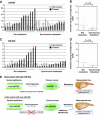miR-493 induction during carcinogenesis blocks metastatic settlement of colon cancer cells in liver
- PMID: 22373578
- PMCID: PMC3321205
- DOI: 10.1038/emboj.2012.25
miR-493 induction during carcinogenesis blocks metastatic settlement of colon cancer cells in liver
Abstract
Liver metastasis is a major lethal complication associated with colon cancer, and post-intravasation steps of the metastasis are important for its clinical intervention. In order to identify inhibitory microRNAs (miRNAs) for these steps, we performed 'dropout' screens of a miRNA library in a mouse model of liver metastasis. Functional analyses showed that miR-493 and to a lesser extent miR-493(*) were capable of inhibiting liver metastasis. miR-493 inhibited retention of metastasized cells in liver parenchyma and induced their cell death. IGF1R was identified as a direct target of miR-493, and its inhibition partially phenocopied the anti-metastatic effects. High levels of miR-493 and miR-493(*), but not pri-miR-493, in primary colon cancer were inversely related to the presence of liver metastasis, and attributed to an increase of miR-493 expression during carcinogenesis. We propose that, in a subset of colon cancer, upregulation of miR-493 during carcinogenesis prevents liver metastasis via the induction of cell death of metastasized cells.
Conflict of interest statement
The authors declare that they have no conflict of interest.
Figures






Similar articles
-
MKK7 mediates miR-493-dependent suppression of liver metastasis of colon cancer cells.Cancer Sci. 2014 Apr;105(4):425-30. doi: 10.1111/cas.12380. Epub 2014 Mar 24. Cancer Sci. 2014. PMID: 24533778 Free PMC article.
-
Long noncoding RNA B3GALT5-AS1 suppresses colon cancer liver metastasis via repressing microRNA-203.Aging (Albany NY). 2018 Dec 10;10(12):3662-3682. doi: 10.18632/aging.101628. Aging (Albany NY). 2018. PMID: 30530918 Free PMC article.
-
Targeting liver sinusoidal endothelial cells with miR-20a-loaded nanoparticles reduces murine colon cancer metastasis to the liver.Int J Cancer. 2018 Aug 1;143(3):709-719. doi: 10.1002/ijc.31343. Epub 2018 Mar 15. Int J Cancer. 2018. PMID: 29492958
-
Identification of microRNA-214 as a negative regulator of colorectal cancer liver metastasis by way of regulation of fibroblast growth factor receptor 1 expression.Hepatology. 2014 Aug;60(2):598-609. doi: 10.1002/hep.27118. Epub 2014 May 28. Hepatology. 2014. PMID: 24616020
-
Role of miR-16-5p in the proliferation and metastasis of hepatocellular carcinoma.Eur Rev Med Pharmacol Sci. 2019 Jan;23(1):137-145. doi: 10.26355/eurrev_201901_16757. Eur Rev Med Pharmacol Sci. 2019. PMID: 30657555
Cited by
-
MicroRNAs as growth regulators, their function and biomarker status in colorectal cancer.Oncotarget. 2016 Feb 9;7(6):6476-505. doi: 10.18632/oncotarget.6390. Oncotarget. 2016. PMID: 26623728 Free PMC article. Review.
-
microRNAs and Corresponding Targets Involved in Metastasis of Colorectal Cancer in Preclinical In Vivo Models.Cancer Genomics Proteomics. 2020 Sep-Oct;17(5):453-468. doi: 10.21873/cgp.20204. Cancer Genomics Proteomics. 2020. PMID: 32859626 Free PMC article. Review.
-
Snail-Modulated MicroRNA 493 Forms a Negative Feedback Loop with the Insulin-Like Growth Factor 1 Receptor Pathway and Blocks Tumorigenesis.Mol Cell Biol. 2017 Mar 1;37(6):e00510-16. doi: 10.1128/MCB.00510-16. Print 2017 Mar 15. Mol Cell Biol. 2017. PMID: 27956702 Free PMC article.
-
MicroRNAs in colorectal cancer as markers and targets: Recent advances.World J Gastroenterol. 2014 Apr 21;20(15):4288-99. doi: 10.3748/wjg.v20.i15.4288. World J Gastroenterol. 2014. PMID: 24764666 Free PMC article. Review.
-
Short hairpin RNA library-based functional screening identified ribosomal protein L31 that modulates prostate cancer cell growth via p53 pathway.PLoS One. 2014 Oct 6;9(10):e108743. doi: 10.1371/journal.pone.0108743. eCollection 2014. PLoS One. 2014. PMID: 25285958 Free PMC article.
References
-
- Bouvet M, Tsuji K, Yang M, Jiang P, Moossa AR, Hoffman RM (2006) In vivo color-coded imaging of the interaction of colon cancer cells and splenocytes in the formation of liver metastases. Cancer Res 66: 11293–11297 - PubMed
-
- Chaffer CL, Weinberg RA (2011) A perspective on cancer cell metastasis. Science 331: 1559–1564 - PubMed
-
- Chambers AF, Groom AC, MacDonald IC (2002) Dissemination and growth of cancer cells in metastatic sites. Nat Rev Cancer 2: 563–572 - PubMed
-
- Chitnis MM, Yuen JS, Protheroe AS, Pollak M, Macaulay VM (2008) The type 1 insulin-like growth factor receptor pathway. Clin Cancer Res 14: 6364–6370 - PubMed
Publication types
MeSH terms
Substances
Associated data
- Actions
LinkOut - more resources
Full Text Sources
Other Literature Sources
Medical
Molecular Biology Databases

